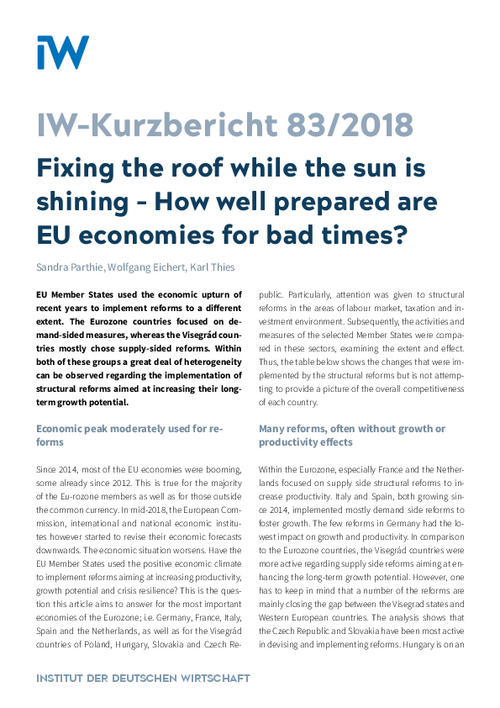EU Member States used the economic upturn of recent years to implement reforms to a different extent. The Eurozone countries focused on demand-sided measures, whereas the Visegrád countries mostly chose supply-sided reforms. Within both of these groups a great deal of heterogeneity can be observed regarding the implementation of structural reforms aimed at increasing their long-term growth potential.

„Fixing the roof while the sun is shining”
IW-Kurzbericht

EU Member States used the economic upturn of recent years to implement reforms to a different extent. The Eurozone countries focused on demand-sided measures, whereas the Visegrád countries mostly chose supply-sided reforms. Within both of these groups a great deal of heterogeneity can be observed regarding the implementation of structural reforms aimed at increasing their long-term growth potential.
Economic peak moderately used for reforms
Since 2014, most of the EU economies were booming, some already since 2012. This is true for the majority of the Eu-rozone members as well as for those outside the common currency. In mid-2018, the European Commission, international and national economic institutes however started to revise their economic forecasts downwards. The economic situation worsens. Have the EU Member States used the positive economic climate to implement reforms aiming at increasing productivity, growth potential and crisis resilience? This is the question this article aims to answer for the most important economies of the Eurozone; i.e. Germany, France, Italy, Spain and the Netherlands, as well as for the Visegrád countries of Poland, Hungary, Slovakia and Czech Republic. Particularly, attention was given to structural reforms in the areas of labour market, taxation and investment environment. Subsequently, the activities and measures of the selected Member States were compared in these sectors, examining the extent and effect. Thus, the table below shows the changes that were implemented by the structural reforms but is not attempting to provide a picture of the overall competitiveness of each country.
Many reforms, often without growth or productivity effects
VWithin the Eurozone, especially France and the Netherlands focused on supply side structural reforms to increase productivity. Italy and Spain, both growing since 2014, implemented mostly demand side reforms to foster growth. The few reforms in Germany had the lowest impact on growth and productivity. In comparison to the Eurozone countries, the Visegrád countries were more active regarding supply side reforms aiming at enhancing the long-term growth potential. However, one has to keep in mind that a number of the reforms are mainly closing the gap between the Visegrad states and Western European countries. The analysis shows that the Czech Republic and Slovakia have been most active in devising and implementing reforms. Hungary is on an average level. Reforms in Poland had the lowest effect on growth.
A focus on corporate taxes and reduction of bureaucracy
The Visegrád countries, Hungary and Slovakia in particular, focused many of their efforts in the areas of fiscal fraud and corruption, as well as on simplifying of the taxation system, and on improving the public administration. These states endeavoured to fit their structures to Western European benchmarks. This catching-up-effect has to be considered when assessing and comparing the structural reforms.
In most of the evaluated countries lower taxation for corporates is seen as the preferred instrument to improve competitiveness. Likewise, most of the countries reduced bureaucracy and aim to make public administration more efficient. Within the Eurozone, France and the Netherlands are precursors in this regard. Having implemented a great deal of reforms between 2009 and 2013, Spain awaits the effects and is currently not introducing many further measures. In contrary, Germany lacks effort and dynamic, the last significant reforms being the so called “Agenda 2010” announced in 2003 and the introduction of minimum wage in 2015.
No uniform trend at the labour market
Discrepancies exist in the field of labour markets regarding pension reforms. Governments have different approaches for the duration of employment and retirement age. While in the Netherlands the retirement age will be linked to life expectancy from 2022 onwards, there seems to be no long-term strategy in Germany. On the other hand, the Czech Republic and Poland will reduce the retirement age. Slovakia on the other hand follows the Dutch approach. There is no clear trend discernible regarding pension systems overall. The eight countries in the sample are faced with different demographic developments and are thus enacting diverse coping mechanisms; but even those with a similar demo-graphic set-up are experimenting in opposite directions.
Apart from pension reforms, most of the countries launched labour market initiatives. However, differences between the states persist: Spain and Slovakia focus on long term unemployment, Hungary and Italy fight youth employment, and the Netherlands and France aim at reducing the fragmentation of the labour market by fostering equal treatment of self-employed and employed persons.
The roof is still not fixed
Regarding the investment environment, most of the countries put an emphasis on higher state expenditures for re-search and development, as well as digitisation, start-ups and infrastructure in order to increase their long-term com-petitiveness. However, in Germany ambitions appear to be low in this domain. Even if there exists a “Digital Strategy 2025”, concrete measures or investments are lacking.
The efforts countries were making during the last years differ massively. With few exceptions the ambitions remained below expectations for these growth-driven times. On average, one third of the reforms did not have any impact on growth and employment. Within the Eurozone as well as among the Visegrád countries, there is small overlap regarding the priorities on reforms. A well-coordinated European economic policy is still far-off. The restrained reform policy will lead to a situation, where urgently needed measures have to be implemented under difficult circumstances. Reforms are more likely to be done when the economic situation worsens, and the resulting burden for economic players in-creases. Just as it is with the roof: it is neglected when the sun is shining, but once a storm appears, repairs are done.

Sandra Parthie / Wolfgang Eichert / Karl Thies: „Fixing the roof while the sun is shining”
IW-Kurzbericht

More on the topic

Strengthened competition in payment services
Starting on January 13, 2018, the Second Payment Services Directive (PSD2) will apply in the European Union. Among other things, the Directive’s aim is to adapt regulation to the innovations in payment services and to promote the Single Market for non-cash ...
IW
An EU comparison: The structure of consumer spending
The purchasing power of EU consumers varies considerably. This is also reflected by the structure of households’ expenditure. The share of food in consumer spending is highest in Romania, one of the countries with the lowest per capita income. On the other ...
IW